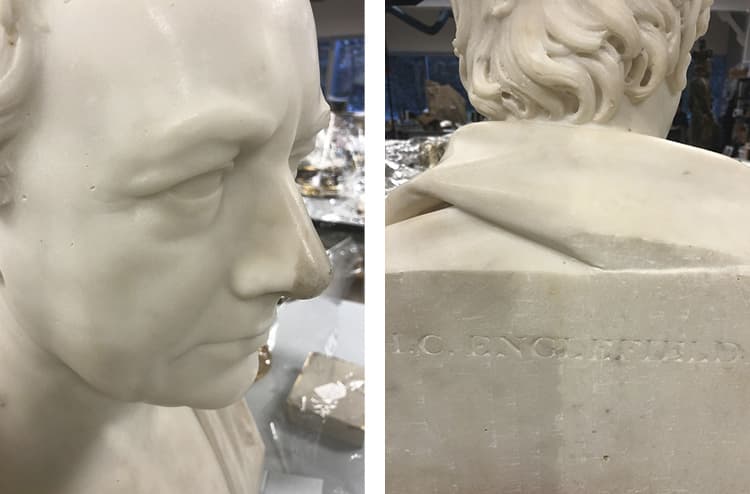
Laser Treatment
- Magazine Article
- Conservation
A new cleaning tool in the conservation laboratories applies technology originally developed for tattoo removal and cosmetic skin treatments

Grime Zapper The laser makes (relatively) quick work of cleaning this marble bust by Francis Legatt Chantrey. At right are two views showing the cleaning in progress, with the face cleaned except for the tip of the nose, and the inscribed back halfway completed.
The conservators at the Cleveland Museum of Art now have a laser that can clean centuries of grime off a marble bust or dirt particles off a feather.
“We’re literally not ruffling feathers,” says Colleen Snyder, associate conservator of objects. “Laser treatment is often viewed as aggressive because of the cutting ability of certain lasers, but light from a laser is surprisingly gentle. Ours is the type of laser that removes tattoos.”
To illustrate the cleaning technique, conservator of objects Beth Edelstein holds out an intricate Chinese headdress ornament decorated with gilded bronze and kingfisher feathers. “It can be difficult to remove brown haze on gold leaf because the gold leaf is so thin,” she says, “plus feathers are too fragile to clean using most methods.”
The versatile Compact Phoenix Laser eliminates some of that trouble. Its intensity can be varied, and its sensitivity is no surprise: it was made by a British company that also produces lasers for cosmetic skin treatments. “We can dial the laser to the exact rate,” Edelstein notes. “Thanks to the generosity of our donors, we were able to get all the bells and whistles that the company makes, including a handpiece with a second type of laser that can break up old varnishes on objects and paintings.”
The laser came to the museum last August through the generous support of Bob Simon of the Simon Family Foundation and that of Albert Leonetti and Ruth Anna Carlson.In November the couple visited the conservation lab to see the laser. Carlson, a member of the Womens Council, says that “a gift to conservation appealed to us because the museum has a wonderful collection, and we want to do our part to take care of it.”
A sculptor and a faculty member of the New York Academy of Art, Simon credits his trips to the CMA as a second grader as having deeply influenced his figurative sculpture practice. During his visit to the conservation lab this past fall, he activated his cell phone flashlight to examine the laser’s work on a marble bust by Francis Legatt Chantrey. “This laser,” he says, “prevents the need to saturate a piece or touch it with anything that could damage it.”
Cleaning an object always requires great care because excessive physical interaction could damage or remove original material. “You can only do so much with dry brushing,” Snyder says. “Then you move on to wet cleaning solutions, always exercising caution and testing them to make sure they won’t cause damage.”
On the Chantrey bust, the dark-colored dirt absorbs the energy of the laser and is vaporized, while the white marble reflects the laser’s light. This makes the laser self-limiting in its cleaning ability, so conservators can go over an area multiple times without risking damage.

Laser cleaning is also a time-saver. Leonetti and Carlson were impressed to learn that the laser allowed conservators to clean the back half of the bust in 20 minutes. “We’re happy to help make this happen,” Carlson says.
The laser system is the size of a desktop copier and sits on a rolling cart. Its handpiece and portable power source make it easy to use on all sizes of artworks. Manufactured by Lynton Lasers in the United Kingdom, the laser was developed for museum professionals by physicist Martin Cooper, who has visited the CMA to train conservators from other museums. “This laser technology has been around for decades, but not until recently has it become more compact, transportable, and affordable,” Snyder says. “While many museums periodically rent a laser, we are fortunate enough to own one.”
“Part of my motivation to fund the laser,” Simon explains, “was to keep the museum at the forefront of a new technology in the conservation field while contributing to the maintenance of the collection.”
Cleveland Art, January/February 2020